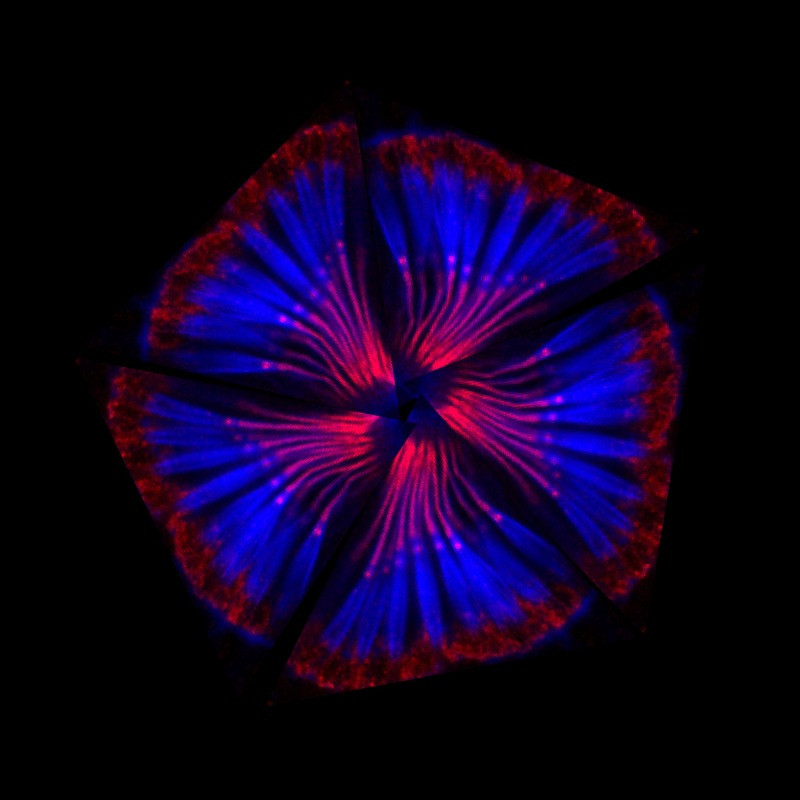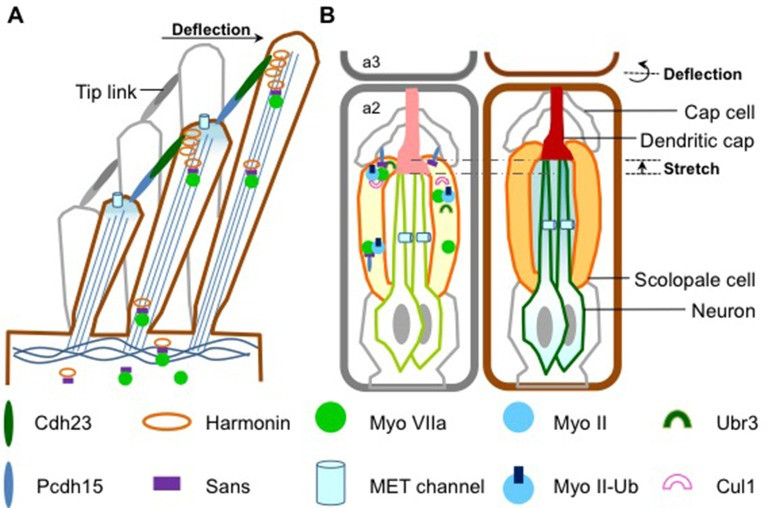While you might not see external ears on a fly like you would on a dog or a cat, the question of whether flies can hear is a resounding yes. In fact, studying how fruit flies (Drosophila melanogaster) perceive sound is providing valuable insights into the complexities of hearing in mammals, including humans. This article delves into the fascinating world of insect auditory systems, revealing how these tiny creatures detect sound and the surprising similarities their hearing mechanisms share with our own.
Beyond Eardrums: How Flies Detect Sound
Flies don’t possess ears in the way we typically understand them. They lack the external ear structures and eardrums that mammals use to capture and process sound waves. Instead, flies rely on their antennae, those prominent sensory appendages on their heads, to perceive vibrations in their environment, including sound.
 A montage of scolopidia – the structures that fruit flies require for hearing
A montage of scolopidia – the structures that fruit flies require for hearing
These antennae are not just for feeling their way around; they are sophisticated auditory organs. Within the second segment of the antenna, flies have specialized structures called scolopidia. These scolopidia are the fruit fly equivalent of our hair cells in the inner ear, acting as the primary sound sensors. They are intricately connected to the fly’s nervous system and are responsible for converting mechanical stimuli from sound waves into electrical signals that the brain can interpret.
The Mechanics of Fly Hearing: Antennae and Scolopidia in Action
Imagine the fly antenna as a highly sensitive receiver. When sound waves reach the fly, they cause the third segment of the antenna to vibrate. This vibration is then relayed to the second segment where the scolopidia are located. Cap cells and scolopale cells within the scolopidia anchor these structures to the joint between the second and third antennal segments.
Furthermore, scolopale cells secrete a protein that forms a dendritic cap, connecting a sensory neuron to this joint. This ingenious design ensures that even minute mechanical forces generated by sound waves are efficiently transmitted to the neuron. This mechanical energy then activates specialized ion channels called mechanoelectrical transduction (MET) channels within the scolopidia. The opening of these MET channels triggers an electrical signal in the sensory neuron, which is then sent to the fly’s brain, allowing it to “hear” the sound.
Unlocking Hearing Secrets: Lessons from Fruit Flies
The seemingly simple hearing system of the fruit fly holds remarkable parallels to the more complex auditory system of mammals. Research into fruit fly hearing has uncovered conserved molecular mechanisms that are crucial for hearing in both insects and mammals. One key area of investigation involves myosin motor proteins.
Myosins are involved in various cellular processes, including intracellular transport and maintaining cell structure. Intriguingly, certain myosins, specifically myosin VIIa and myosin IIa, play critical roles in mammalian hearing. Dysfunction of these proteins is linked to deafness, including Usher syndrome, a severe genetic disorder causing both deafness and blindness.
Scientists are using fruit flies to unravel the intricate interactions of these myosin proteins. A recent study highlighted the role of an enzyme called Ubr3 in regulating the interplay between myosin II and myosin VIIa in the auditory organs of Drosophila.
Ubr3: A Key Regulator in Hearing – Fly and Mammalian Insights
Researchers discovered that Ubr3, an E3 ubiquitin ligase, is enriched in the tips of scolopidia in fruit flies. This enzyme, along with another ligase called Cul1, regulates the “mono-ubiquitination” of myosin II. Mono-ubiquitination is a process where a single ubiquitin protein is attached to another protein, influencing its function or interactions.
In flies, Ubr3 and Cul1 act to negatively regulate mono-ubiquitination of myosin II. When Ubr3 is absent or inactive, mono-ubiquitination of myosin II increases. This seemingly small change has significant consequences: it strengthens the interaction between myosin II and myosin VIIa. This interaction is crucial for the correct localization of both myosin proteins, as well as the fly equivalents of Usher syndrome proteins, to the tips of the scolopidia.
This research indicates that Ubr3 plays a vital role in maintaining the structure and function of scolopidia, and by extension, the fly’s ability to hear. Importantly, the findings suggest a conserved mechanism for hearing across species.
A Conserved Hearing Model: From Flies to Humans
The research on Ubr3 and myosin interactions in fruit flies strengthens the idea of a shared, fundamental model for hearing in both insects and mammals. This model proposes that the precise regulation of mono-ubiquitination of myosin II (or myosin IIa in mammals) by Ubr3 promotes the formation of a myosin II/myosin VIIa protein complex.
 Figure 1. How sound is detected in mammals and Drosophila.
Figure 1. How sound is detected in mammals and Drosophila.
This myosin complex then acts as a transporter, delivering Usher syndrome proteins (USH1 proteins) to the critical locations at the tips of stereocilia in mammalian hair cells, and scolopidia in flies. These USH1 proteins are essential for building and maintaining the sound-sensing apparatus that enables the MET channels to function correctly and transduce sound into electrical signals.
By leveraging the power of fruit fly genetics, scientists are identifying new components and mechanisms involved in the development and function of auditory organs. Linking these discoveries to genes already known to play a role in human deafness, like those involved in Usher syndrome, offers promising avenues for understanding and potentially treating hearing disorders. Future research into these deafness-related genes in Drosophila will undoubtedly provide even deeper insights into the complex molecular interplay required for hearing, benefiting both our understanding of basic biology and human health.
References
Li T, Giagtzoglou N, Eberl D, Nagarkar-Jaiswal S, Cai T, Godt D, Groves AK, Bellen HJ. 2016. The E3 ligase Ubr3 regulates Usher syndrome and MYH9 disorder proteins in the auditory organs of Drosophila and mammals. eLife 5:e15258. doi: 10.7554/eLife.15258
Richardson et al., 2011
Weil et al., 1995
Kazmierczak et al., 2007
Pan and Zhang, 2012
Richardson et al., 2011
Boekhoff-Falk and Eberl, 2014
Todi et al., 2005
Todi et al., 2008